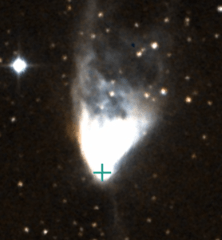Star of the Month
R Monocerotis
AKA: BD+08 1427
Position: 06 hrs 39 min 10.0 sec +08 degrees 44 min 10 sec
Due south at 22.59 (GMT) on 15 January 2022
R Monocerotis (shown with a cross) embedded in NGC 2261
Image: Simbad (http://simbad.u-strasbg.fr/simbad/)
There is another interesting object just below the Christmas Tree Cluster (see DSO of the Month for January 2022), but unfortunately it is very dim, being only magnitude 10 to 12 and you either have to use a large telescope or astro-imaging to see it. This is the variable star R Monocerotis, which (like many of the stars in the Christmas Tree Cluster) is a hot massive star which is less than a million years old. It is dim partly because it is no less than 2,600 light years away, slightly further away than the Christmas Tree Cluster, but mainly because of the dust surrounding it. It is a B type star, but more importantly it is a Herbig Ae/Be pre-main sequence star with a circumstellar disc of gas and dust. Such stars are often associated with nebulosity and it is embedded in NGC 2261, better known as Hubble’s Variable Nebula.
The gas in NGC 2261 is illuminated by a cone of light from R Monocerotis which is not directly visible to us because of the dust disc. Hubble’s Variable Nebula, which is also Caldwell 46, was discovered by William Herschel in 1783 but its variability was detected by Edwin Hubble. It was given the honour of being the “first light” object of the 200 inch Hale telescope at Mount Palomar by Hubble on 26 January 1949. Being magnitude 9, it is somewhat easier to see than R Monocerotis. Indeed it has even been argued that R Monocerotis is just a bright patch of gas within the nebula and is not a star at all. To find R Monocerotis/NGC 2261, look below the Christmas Tree Cluster and slightly to the right or east in the direction of the Rosette Nebula (NGC 2244). It is half-way between Gomeisa (Beta Canis Minoris) which is magnitude 2.9 and Betelgeuse, and forms a right-angle triangle with S Monocerotis and 17 Monocerotis.
